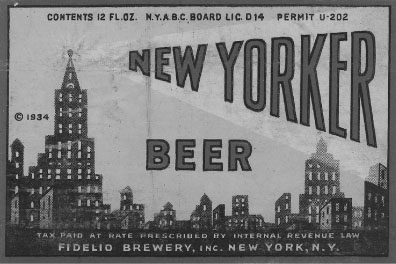Manhattan, New York. The first brewery on Manhattan was built in a log house. It was among several structures in a fort erected by Dutch colonists Adrian Block and Hans Christiansen about 1612 on the southern tip of the island. These buildings also were the birthplace of the first white child born in Manhattan, Jean Vigne, who became the first brewer born in America and a prominent citizen. Dutchman Peter Minuit purchased the island from native Americans in 1626 and named it New Amsterdam. In 1629, there were only 350 people in the settlement. “About three years later, however, the West India Company saw fit to build a brewery not far from the fort, on a street which became known afterward as ‘Brouwers (Brewers’) Straet,” writes Stanley Baron in his book, Brewed in America. Vigne was the brewer. The water for the brewery came from the Heere Gracht, a stream flowing from natural springs through Beaver path, now known as Beaver Street. In the 1640s and 1650s, a succession of colonial governors, including Peter Stuyvesant began to collect taxes of the production and sale of beer. The first excise taxes on beer aroused the opposition of the brewers and the citizenry, but the governors did not relent. A 1644 tax amounted to two guilders (80 cents) on each half vat, or barrel, of beer tapped. Half was paid by the brewer and half by the tapster, or retailer. The taxes were used to repair stockades, pay soldiers, and wage war against the Native Americans.
Stuyvesant also waged a crusade against drunkenness and carousing on the Sabbath. Inn keepers were prohibited from serving “any wines, beers, or any strong waters” to anyone but travelers and boarders on Sundays. Violators were liable to finesand suspension of business. Taverns were forced to close at 9 pm in the evening. All retailers of alcoholic beverages were required to obtain licenses. Sale of liquor to Native Americans was forbidden.

Beer label, c. 1934—shortly after the repeal of the Volstead Act and end of Prohibition—from the Fidelio Brewery in Manhattan. pike microbrewery museum, seattle, wa
When the English took over administration of New Amsterdam from the Dutch in 1664, the Duke of York issued new regulations known as the Duke’s Laws which stipulated that “… no person whatsoever shall henceforth undertake the calling or work of brewing beer for sale, but only such as are known to have sufficient skill and knowledge in the art and mystery of a brewer.”
There were several important breweries in Manhattan. The two most prominent were George Ehret’s Hell Gate Brewery, built on the East side of the city where the East River, Harlem River, and Long Island Sound merge in the rough water known as Hell Gate, and the Ruppert brewery, owned by Colonel Jacob Ruppert. He also served in Congress, owned the New York Yankees, built Yankee Stadium, and brought the legendary baseball star Babe Ruth to the team.
100 years of brewing, a complete history of the progress made in the art, science and industry of brewing in the world, particularly during the nineteenth century; a supplement to The Western brewer. Chicago: H.S. Rich & Co., Publishers, 1903.
